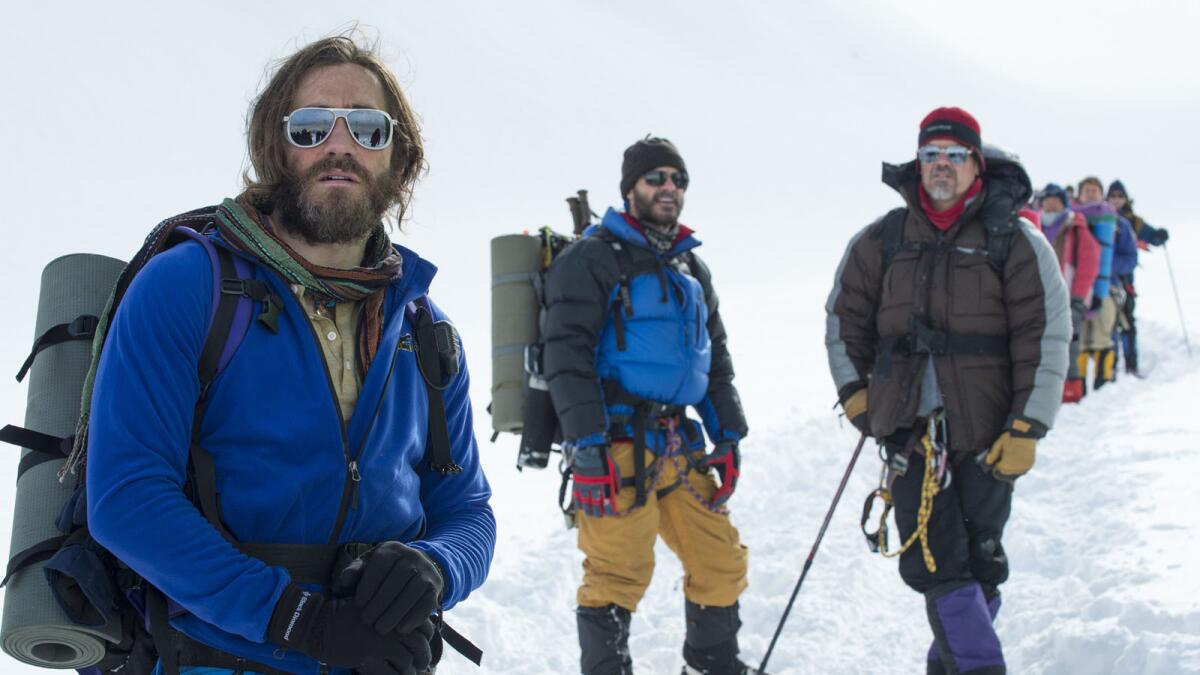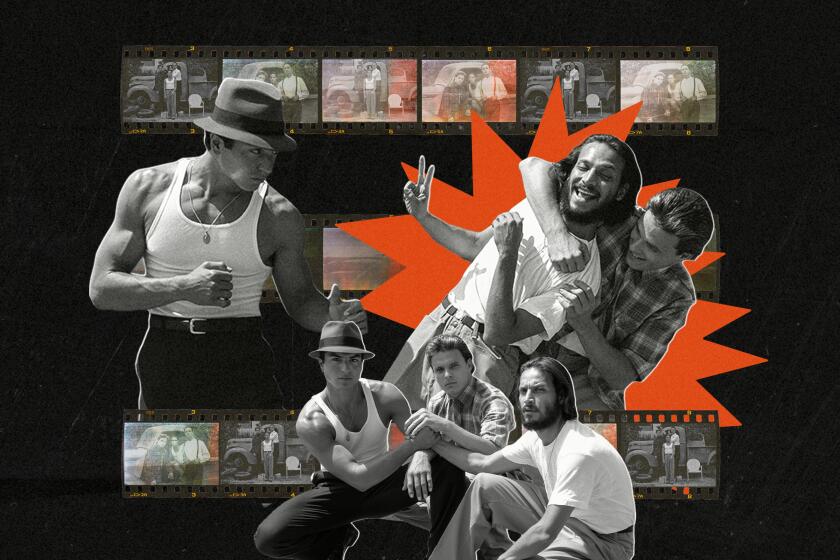‘Everest,’ ‘The Walk’ studios gamble big with limited-release strategy on Imax

“Everest,” which follows a tragic 1996 expedition on the world’s highest mountain, has a top-flight ensemble cast that includes, from left, Jake Gyllenhaal, Michael Kelly and Josh Brolin.
In the movie business, a “limited release” — opening a movie on only a few screens before expanding to more theaters — is usually done for a small, independent movie that needs time to build buzz to attract wider audiences.
But in the case of two new studio movies, the limited release is aimed at something bigger — namely Imax screens.
“The Walk,” from Sony’s TriStar label, is being released on more than 440 Imax and other select large-format theaters on Wednesday before going into general release on Oct. 9. Two weeks ago, Universal Pictures took a similar approach for “Everest”: The studio opened it up on 545 Imax 3-D and premium large-format 3-D theaters in North America and then went wide a week later with 3,006 theaters.
SIGN UP for the free Indie Focus movies newsletter >>
According to Greg Foster, chief executive of Imax Entertainment, both films contain “something Imax specific” that makes them fit for the format and an untraditional roll-out.
The strategy is working for “Everest,” a film from Universal, Working Title, Cross Creek Pictures and Walden Media. After its limited launch, it rounded out the top five at the box office, collecting an impressive $7.6 million. In its second weekend, the film jumped to fourth place. To date, it’s made $97.4 million worldwide.
The intent of this type of roll-out is similar to traditional use of limited release: to build buzz. But in these cases, the strategy is based on the strong visual components of these movies — the tightrope walk across the World Trade Center towers in “The Walk” and the mountain climbing in “Everest” — that are more spectacular in Imax 3-D.
“I think what major studios are learning right now is that word-of-mouth is more important than ever,” said Phil Contrino, vice president and chief analyst at BoxOffice.com. “Imax ... is where you’re going to get the most bang for your buck because it’s where the most enthusiastic moviegoers are. If they like a movie, then word spreads quickly.”
“Everest” opened up the window for the Imax limited release for a week. “The Walk” will play exclusively on Imax for nine days until the wide release next Friday.
On average, the North American Imax ticket price is about $15.50, several dollars higher than the movie ticket average, depending on geographic region.
This type of distribution strategy has been used before, most notably for Paramount Pictures’ “Mission Impossible: Ghost Protocol” in 2011.
The Brad Bird-directed film, part of which was shot on Imax cameras, opened with $13.85 million in its limited release on 325 Imax screens five days before the wide Christmas release. It went on to gross $694.9 million worldwide, with Imax playing a large role in its initial promotion.
Since then, however, studios haven’t taken many chances on putting a film on the bigger screen first for longer than one to three days. Even Christopher Nolan’s “Interstellar,” which was partially shot on 65-millimeter Imax film, opened on Imax screens in limited release only two days ahead of its nationwide launch.
Foster said that after the success of “Ghost Protocol,” the company was “really close” to doing similar partnerships with studios for other movies. However, “the movies themselves didn’t have what the studios felt would be the word-of-mouth to be able to justify it.”
“Everest,” which follows a tragic 1996 expedition on the world’s highest mountain, has a top-flight ensemble cast that includes Jason Clarke, Jake Gyllenhaal, Josh Brolin, John Hawkes, Robin Wright, Keira Knightley and Emily Watson. The scenes of the final trek to the top of “Everest” — including a catastrophic storm that hits the climbers — are vivid and frightening, especially in 3-D. Audiences for the film gave it an A, according to polling firm CinemaScore.
“I think with increased marketing attached to the film and the build-up to the wide release, it absolutely helped put the word out to everyone how important it was to see this movie,” said Nick Carpou, Universal’s head of domestic distribution. “From our standpoint, it was a good idea” to do the Imax limited release.
Rory Bruer, Sony’s head of distribution, echoed Carpou’s notion that Imax helps films get added exposure.
“It really is one of those immersive formats,” he said. “I think when you have it in Imax, particularly in a very limited way, people know that you’re bringing something that is going to be visually spectacular.”
“The Walk,” which cost $35 million to make, has also been lauded for its visual effects since premiering at the New York Film Festival last weekend. The movie follows French high-wire artist Philippe Petit (Joseph Gordon-Levitt) as he walks between the World Trade Center towers.
Sony expects the film to make about $3 million over its five-day limited opening. Early tracking suggests next weekend it could add up to $16 million when it goes into wide release.
“You really are making a bet,” Foster said of the limited-release Imax strategy. “You have to be incredibly confident you’ve got something.”
MORE:
‘It’s total bull’: Jon Krakauer hates ‘Everest,’ praises Sean Penn and just made a doc on polygamy
New York Film Festival could bring Oscar buzz for movies such as ‘The Walk’ and ‘Steve Jobs’
Director Robert Zemeckis walks ‘The Walk’ as a quixotic filmmaker
More to Read
Only good movies
Get the Indie Focus newsletter, Mark Olsen's weekly guide to the world of cinema.
You may occasionally receive promotional content from the Los Angeles Times.







